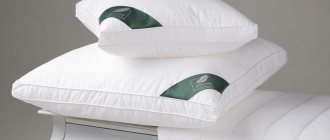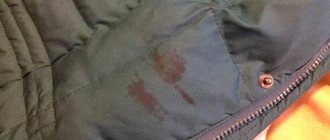Every family uses backpacks. Some people go fishing with them, others go to school, and for some they are an indispensable attribute of style. And they all face the question: “Is it possible to wash a backpack in a washing machine?” Agree, using a clean bag is much more pleasant than using a dirty one. Our tips will help you understand the intricacies of when and how to wash a backpack in an automatic washing machine. Moreover, our advice is arranged in a logical sequence: from studying labels to care recommendations.
Read the backpack manufacturer's recommendations!
Because this product is made from fabric, businesses must sew labels with important information into the side seam. It certainly contains symbols on how to wash, dry and iron a particular backpack so that it retains its original appearance. If you follow these recommendations, you will be able to extend its service life.
It happens that there is no information on how to wash an item in a washing machine. Then you need to choose the most gentle washing mode, which is characterized by a minimum temperature and spin speed. They should be equal to 30 degrees and 400 revolutions, respectively.
The choice of numeral means should also be approached responsibly. To wash backpacks, it is recommended to use powders for delicate fabrics or gel products.
There is one type of backpack that is prohibited from washing. They are impregnated with a special water-repellent agent. Washing will destroy this substance and even destroy the fabric.
If the fabric of the backpack is too thick, it will be almost impossible to rinse, which means cleaning products will remain in it. This will cause premature failure of parts subject to high loads.
Cleaning the backpack cavity
Before loading the product into the washing machine, it is checked for the presence of small things inside (coins, keys). Such measures are necessary to avoid negative impacts on the machine and the thing itself. If there are coins inside, they can oxidize in an aqueous environment, which can cause stains and rust to appear on the fabric. If there are crumbs and other debris, they need to be shaken out or cleaned with a vacuum cleaner.
Preparation
Hooks and straps can damage the washing machine, so they must be unfastened. Other hard elements of the product are removed. For the same reason, if possible, it is better to remove plastic carabiners and latches for manual cleaning. The protruding threads on pockets, zippers, and fastenings are cut off so that they do not spoil the item during processing by catching on other parts.
Before starting the device, each contaminated area is wiped with a wet cloth. Dried dirt can cause stains on your bag when exposed to water. If there are heavily soiled areas (stains), they are removed before washing. Before the procedure, you should treat the most contaminated areas with a stain remover or laundry soap, rub with a brush and rinse. The inside of the product may also contain stains (ink, drinks). In case of heavy contamination, the bag is soaked in warm water for an hour and a half. You just need to add soap (can be grated with shavings) and baking soda.
When machine washed, the pockets and snake sections wash much less well.
Wet express cleaning
Some fabrics cannot be wetted with water. The surface of such materials is quite delicate or decorated with accessories that cannot be removed. Therefore, before cleaning a backpack that cannot be washed, you need to familiarize yourself with the basic operating rules:
- Only soft wool brushes are used to clean delicate fabrics.
- Movements should be gentle and smooth. For hard-to-reach areas, it is recommended to use a special vacuum cleaner with the “Steam” mode.
For express cleaning, use a vacuum cleaner. It can be used to clean the product from dust and debris.
Step-by-step instruction:
- Before washing the school backpack, it must be disassembled. Separate the orthopedic back, remove the hanging pockets, accessories and belts.
- Using a vacuum cleaner, clean the surface of the fabric from debris and dust.
- Use a soft brush to clean the folds and seams. If dirt is difficult to remove, the area can be wet.
- Wipe leather inserts with damp wipes.
- After cleaning the backpack, it must be folded in the same order in which it was disassembled.
Wet express cleaning does not remove large and complex stains. This is just a superficial cleaning of the product.
We disassemble the backpack
Clean folds and seams with a brush
Wipe with wet wipes
Studying the manufacturer's recommendations
Any backpack must have a label from the manufacturer in the inner cavity. Almost always, this label contains information with instructions regarding washing, drying, ironing, which extends the life of the product and preserves its original appearance. The label is located in the side seam area. The explanation of the information on the label is available on the Internet; you just need to follow the recommendations.
It is important to remember that in the case of rough mechanical impact and aggressive processing mode, the structure of the fibers and the shape of the product loses its original properties. The water repellency function is disrupted and the threads will fray along the main seams. To prevent this, unauthorized choice of temperature and push-up strength is not recommended. It is unreasonable to expect a backpack to withstand elevated temperatures and twisting.
If there is no label with information on the bag, you should choose a gentle mode that does not exceed 400 rpm. Available for hand or delicate wash. Cleaning agents are selected as for delicate fabrics.
Is it washable?
Every backpack needs to be cleaned from time to time. To understand how to properly care for your product, you need to refer to the manufacturer's recommendations.
They are encrypted in the form of icons, which are presented on the product label. Most often it is located inside.
It is not recommended to machine wash backpacks made of delicate fabrics. Other contraindications include:
- The presence of a large number of stripes and reflective details.
- The presence of a solid non-removable frame or USB port.
- Availability of photo print.
- The presence of obvious defects, broken fittings, unraveling seams.
Do not automatically wash bags impregnated with a water-repellent compound or other coating that changes its characteristics upon contact with liquid.
Instructions for washing the backpack
- You need to find the label on the backpack and follow the advice. If it is absent, you need to proceed to the next action.
- It is necessary to determine the material of manufacture of the product, most often it is tarpaulin or nylon, suitable for machine washing. If the material of manufacture is unknown, then you need to proceed to step No. 10.
- A backpack with several straps is washed in a special washing bag (large pillowcase) or it is turned inside out and all the straps are put inside. A bag or pillowcase is necessary so that the fasteners do not get stuck in the drum of the machine and do not damage its walls.
- Washing is performed in a gentle mode (gentle or delicate). For maximum protection of the backpack, only cold water should be used to prevent discoloration (up to 40 degrees).
- A safe powder is added and the machine is turned on. Due to the higher density of the fabric, rinsing is more difficult, so rinse aid may be required for colored items.
- The washing process must be controlled. When washing one backpack, the washing machine is unlikely to be able to balance it correctly. Then, in order to avoid distortion and imbalance in the internal compartment of the machine, the washing is paused and the correct position of the product is manually maintained so that it does not wrinkle.
- When the wash finishes, the item is removed. Remove excess water from the outside and inside using a dry cloth.
- If there is foam in the inside of the item, drying is done on a rope. A nylon product will dry quickly both in the sun and in the shade. If there is no foam or the backpack is canvas, then you can use a dryer.
- The tarpaulin product is dried on a low or medium dryer setting, which can take a long time.
- If automatic washing does not work, you should use the manual mode. The product is placed in a large container or bath.
- Rinse is in progress.
- A good spin is done.
- Drying is carried out as in step No. 8.
Choosing a detergent
To wash school bags, you can use liquid gel, granular powder or soap shavings. It is best to choose a product for delicate fabric; it is suitable for backpacks made of various materials.
Powders:
- “Vorsinka” – 60–100 rubles. for 350 g;
- “Cashmere” – 70–100 rubles. for 350 g;
- Tide – 70–100 rub. for 450 g;
- “Weasel” – 100–150 rubles. for 280 g;
- Sarma – 70–100 rub. for 400 g.
Consumption per wash is 20–30 g per 1 kg of laundry.
Gels:
- Flat – 170–200 rub. for 950 ml;
- Help – 190–220 rub. for 2 l;
- Dreft – 140–180 rub. for 800 ml;
- “Vorsinka” – 130–170 rubles. for 750 ml;
- Meine Liebe – 300–380 rub. for 800 ml.
Average product consumption: 25–50 ml per 1–2 kg of laundry.
Recommendations and tips
You can learn how to properly machine wash a backpack by following these recommendations:
- In the absence of a label, information about the material is contained in the official website of the trademark.
- Washing uses powder, liquid or gel. The gel has a more gentle effect and is easier to rinse from the fabric structure. There is a special type of washing powder that is used to wash camping equipment. This product is not cheap, it has no odor, and does not contain disinfectants or additives.
- If using a stain remover, it is better to test it on a small part of the inside of the item.
- When the wash is finished, it is better to immediately remove the product from the drum so that mold does not appear from dampness.
- If the label contains information permitting the use of high temperatures, it is safer to maintain moderate temperatures to avoid deformation of the item and loss of color.
- Before the process, to assess the quality of painting, you need to run a wet finger over the bag. If traces of dye remain, it is better to use a product with the most gentle effect and cool water. It is advisable not to wash the item with other items.
- If the backpack has a high cost, an exclusive model and you don’t want to take risks, then you can have it professionally dry-cleaned.
- In case of loss of water-repellent properties, shine, or appearance, which are often characteristic of nylon products, a special water-repellent spray is used on the fabric to restore the water-repellent effect.
Is it possible or not?
There should be a label on the inside of the backpack indicating whether the backpack can be washed and what types of processing of the product are allowed.
Depending on the model, the following types of cleaning are possible:
- manual;
- in the washing machine;
- dry;
- dry cleaning
The latter option involves completely eliminating self-processing and transferring washing to professionals.
Dry cleaning is often used as an intermediate step before the main wash . But for some types of backpacks, it is the only way to put things in order.
To maintain a school backpack in hygienic condition, it is recommended to wash it once every 3 months.
Which backpacks are not machine washable?
Not every backpack can be machine washed. This option is not suitable for the following cases:
- Backpack with a solid frame (wooden, chipboard). Washing may cause loss of shape due to exposure to water. When using a plastic frame, stainless steel, or other moisture-resistant materials, it can be washed, but hard parts will need to be removed.
- For an orthopedic backpack, washing is not advisable because it is most likely equipped with a non-removable frame and has significant dimensions. There may not be enough space for the item in the drum, it may damage it or become deformed.
- Some backpacks have a water-repellent coating or other protective coating that prevents the penetration of water. Washing using powder will lead to a change or washing off of the composition, and the original properties will be lost.
- Leather products (as well as eco-leather items) cannot be washed. They can be wiped with a wet cloth. Contaminants are removed using a soap solution.
- If machine washing is not recommended by the manufacturer, this should be taken into account.
Machine washing is not allowed if the following is used to make the backpack:
- kondura - thickened nylon fabric made from a thread of a special structure, which has a water-repellent impregnation;
- Oxford is a synthetic material made from polyester;
- avisent - for the manufacture of the material, high-strength nylon thread using special weaving is used.
If the fabric is of unknown origin and there is no information about this on the label, then it is better not to machine wash it.
Is it possible to wash backpacks in a washing machine and how to pre-treat stains
If the material has strong stubborn dirt, it must be treated with a chemical cleaner before placing it in the washing machine. Do not use bleaches, as they can damage the structure of the fabric. To remove stubborn dirt, the stain remover is applied to the contaminated area and rubbed in with a toothbrush. After 20 minutes, a Deuter, Dakini briefcase or a backpack of another brand can be placed in the washing machine.
Article on the topic: What to do if water leaks from the washing machine
If you don’t have stain remover at home, don’t despair; you can make it yourself. To do this, mix water and dishwashing liquid in equal proportions. The resulting solution is also applied using a toothbrush.
Is it possible to wash a backpack without pre-treating stains? It is possible if the material is not heavily soiled and the washing is done to refresh the material and color.
Keeping it clean for long-term use
If you frequently machine wash your backpack, it may harm it. To avoid washing too often, there are a few precautions you should take:
- do not collect various rubbish inside, empty pockets, send everything unnecessary directly to the trash bin;
- do not place the bag on the ground, you can hang it;
- keep the inside clean (for example, in school backpacks, shoes and other items can be wrapped in a bag);
- Pens, felt-tip pens, drinks, and other liquids may cause stains that are difficult to remove, so you should take care of additional packaging;
- Wet wipes will help remove fresh stains and dirt.
By following these tips you can significantly increase the life of your backpack.
What to do with stains
Fresh stains from any fabric can be removed immediately with a damp sanitary napkin. Then you should wipe the affected area with a damp cloth. However, it is not always possible to do this right away. Therefore, the cleaning method depends on what the item is stained with:
- a stain of grease on a school backpack or briefcase is common; it is recommended to sprinkle it with salt, baby powder or starch and press down lightly, and after an hour, brush off the grains and wash the entire thing or wash the affected area if it is not possible to wash the whole thing;
- An anti-grease gel designed for cleaning stoves and ovens will also help remove grease;
- ink and paste from ballpoint pens can be removed with alcohol, but you can only rub products made of leather or faux leather, having first made sure that the alcohol will not damage the material; in other cases, apply a cotton wool soaked in alcohol to the stain, then carefully remove it, running along it from the edges to the center , repeat the procedure several times;
- many stains can be removed by laundry soap; you need to soap the affected area and leave for a couple of hours, and then rinse with warm water;
- Chewing gum is afraid of frost; you can easily remove it by putting your backpack in the freezer of the refrigerator for several hours, and then simply remove the gum.
Important! Before applying any product to the entire item, it must be tested on an inconspicuous area of the fabric on the back side, as well as on the back side of the plastic parts.
We recommend:
How to remove tangerine stains
Proper drying of a backpack
The natural drying method for a backpack is most suitable, and it is better with open pockets so that they dry better. If the conditions outside for drying are unsuitable (rain, winter), it is not recommended to dry it in a dryer. In the room itself, the conditions for this will be much better, and it’s worth leaving the backpack to dry at home.
Do not put your backpack in the closet until it is completely dry. Leaving wet areas of the fabric can cause mildew and an unpleasant odor that may not be easy to remove.
How to eliminate bad odor
An unpleasant odor in a backpack can occur for a dozen reasons. In the urban version, you can forget/spill/scatter the mess; in the sports or tourist version, you can add the unpleasant smell of sweat from sportswear. In any case, the unpleasant odor must be dealt with somehow. Here are some simple ways:
- Ventilation. If the bag has been sitting for several years with forgotten used sports items, then the smell will obviously not be pleasant. It is enough to take out your things and ventilate and dry your backpack.
- Wash. If this does not help, then washing will usually be enough. Make sure to dry your backpack thoroughly to avoid mold problems.
- Ammonia. If the contamination is excessively strong, then you can use an alcohol-containing product. It not only removes dirt, but also kills germs, thereby eliminating odor.
- Table bite. True, vinegar itself does not have the most pleasant smell. It kills almost any odor, but you should wash your backpack afterward to get rid of the vinegar smell.











